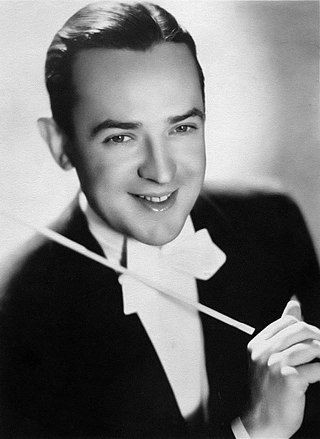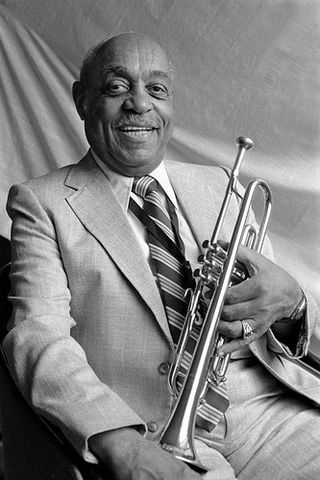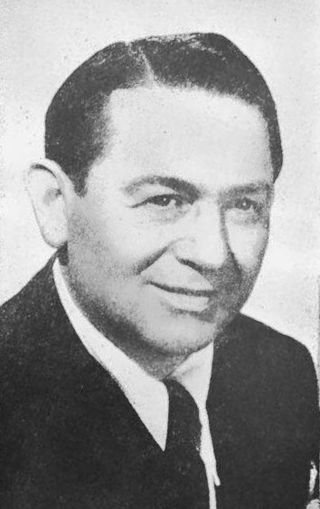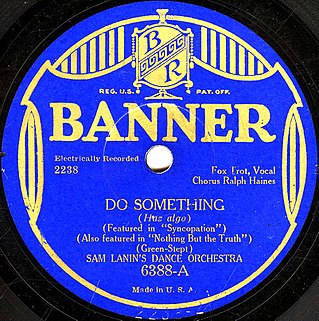Related Research Articles

A big band or jazz orchestra is a type of musical ensemble of jazz music that usually consists of ten or more musicians with four sections: saxophones, trumpets, trombones, and a rhythm section. Big bands originated during the early 1910s and dominated jazz in the early 1940s when swing was most popular. The term "big band" is also used to describe a genre of music, although this was not the only style of music played by big bands.
Swing music is a style of jazz that developed in the United States during the late 1920s and early '30s. It became nationally popular from the mid-1930s. The name derived from its emphasis on the off-beat, or nominally weaker beat. Swing bands usually featured soloists who would improvise on the melody over the arrangement. The danceable swing style of big bands and bandleaders such as Benny Goodman was the dominant form of American popular music from 1935 to 1946, known as the swing era, when people were dancing the Lindy Hop. The verb "to swing" is also used as a term of praise for playing that has a strong groove or drive. Musicians of the swing era include Duke Ellington, Benny Goodman, Count Basie, Cab Calloway, Jimmy Dorsey, Tommy Dorsey, Woody Herman, Harry James, Lionel Hampton, Glenn Miller, Artie Shaw, Jimmie Lunceford, and Django Reinhardt.

Ernest Loring "Red" Nichols was an American jazz cornetist, composer, and jazz bandleader.

James Francis Dorsey was an American jazz clarinetist, saxophonist, composer and big band leader. He recorded and composed the jazz and pop standards "I'm Glad There Is You " and "It's The Dreamer In Me". His other major recordings were "Tailspin", "John Silver", "So Many Times", "Amapola", "Brazil ", "Pennies from Heaven" with Bing Crosby, Louis Armstrong, and Frances Langford, "Grand Central Getaway", and "So Rare". He played clarinet on the seminal jazz standards "Singin' the Blues" in 1927 and the original 1930 recording of "Georgia on My Mind", which were inducted into the Grammy Hall of Fame.

Bennett Lester Carter was an American jazz saxophonist, clarinetist, trumpeter, composer, arranger, and bandleader. With Johnny Hodges, he was a pioneer on the alto saxophone. From the beginning of his career in the 1920s, he worked as an arranger including written charts for Fletcher Henderson's big band that shaped the swing style. He had an unusually long career that lasted into the 1990s. During the 1980s and 1990s, he was nominated for eight Grammy Awards, which included receiving a Lifetime Achievement Award.
The swing era was the period (1933–1947) when big band swing music was the most popular music in the United States. Though this was its most popular period, the music had actually been around since the late 1920s and early 1930s, being played by black bands led by such artists as Duke Ellington, Jimmie Lunceford, Bennie Moten, Cab Calloway, Earl Hines, and Fletcher Henderson, and white bands from the 1920s led by the likes of Jean Goldkette, Russ Morgan and Isham Jones. An early milestone in the era was from "the King of Swing" Benny Goodman's performance at the Palomar Ballroom in Los Angeles on August 21, 1935, bringing the music to the rest of the country. The 1930s also became the era of other great soloists: the tenor saxophonists Coleman Hawkins, Ben Webster and Lester Young; the alto saxophonists Benny Carter and Johnny Hodges; the drummers Chick Webb, Gene Krupa, Jo Jones and Sid Catlett; the pianists Fats Waller and Teddy Wilson; the trumpeters Louis Armstrong, Roy Eldridge, Bunny Berigan, and Rex Stewart.

Giuseppe "Joe" Venuti was an American jazz musician and pioneer jazz violinist.

Orie Frank Trumbauer was an American jazz saxophonist of the 1920s and 1930s. His main instrument was the C melody saxophone, a now-uncommon instrument between an alto and tenor saxophone in size and pitch. He also played alto saxophone, bassoon, clarinet and several other instruments.

Frederic Efrem Rich was a Polish-born American bandleader and composer who was active from the 1920s to the 1950s. Among the musicians in his band were the Dorsey Brothers, Joe Venuti, Bunny Berigan, and Benny Goodman. In the early 1930s, Elmer Feldkamp was one of his vocalists.
Leo F. Reisman was an American violinist and bandleader in the 1920s and 1930s. Born and reared in Boston, Massachusetts, United States, he was of Jewish ancestry, from German immigrants who immigrated to the United States in the 19th century. Inspired by the Russian-American violinist Jascha Heifetz, Reisman studied violin as a young man. After being rejected by the Boston Symphony Orchestra, he formed his own band in 1919. He became famous for having over 80 hits on the popular charts during his career. Jerome Kern called Reisman's orchestra "The String Quartet of Dance Bands".

Joseph Samuels was an American musician and bandleader, who is today virtually only known through his recordings.

Jan Garber was an American violinist and jazz bandleader.

Samuel Charles Lanin was an American jazz bandleader.

Sykes "Smith" Ballew was an American actor, sophisticated singer, orchestra leader, and a western singing star. He also was billed as Buddy Blue, Charles Roberts, and Billy Smith.
Vernon Andrade was an American jazz bandleader active primarily in New York City in the 1920s and 1930s.

"Heebie Jeebies" is a composition written by Boyd Atkins which achieved fame when it was recorded by Louis Armstrong in 1926. Armstrong also performed "Heebie Jeebies" as a number at the Vendome Theatre. The recording on Okeh Records by Louis Armstrong and his Hot Five includes a famous example of scat singing by Armstrong. After the success of the recording, an accompanying dance was choreographed and advertised by Okeh.

"Margie", also known as "My Little Margie", is a 1920 popular song composed in collaboration by vaudeville performer and pianist Con Conrad and ragtime pianist J. Russel Robinson, a member of the Original Dixieland Jazz Band. Lyrics were written by Benny Davis, a vaudeville performer and songwriter. The song was introduced by the Original Dixieland Jazz Band in 1920 as Victor 78, 18717-A, in a medley paired with "Singin' the Blues". The B side was "Palesteena". The ODJB recorded their instrumental version on December 1, 1920.
Other popular versions in 1920-21 were by Gene Rodemich; Eddie Cantor; Ted Lewis; and Frank Crumit. The Rega Dance Orchestra recorded the song in October, 1920 for Okeh Records, 4211.
Bernard Joseph Cummins was an American jazz drummer and bandleader.
Eugene Staples, better known by the stage name Blue Steele was an American jazz singer, trombonist and bandleader. He also played mellophone.
Griffith (Griff) Evan Williams was an American dance bandleader and pianist.
References
- ↑ Leo Walker, The Big Band Almanac. Ward Ritchie Press, 1978, p. 291.
- ↑ "Benny Meroff". Colin Larkin, Encyclopedia of Popular Music. 4th edition, 2006.
- ↑ "Discography of American Historical Recordings: Benny Meroff Orchestra (Musical group)" . Retrieved 2019-02-12.
- ↑ "Internet Archive, Benny Meroff Orchestra 78rpm Collection". Archive.org. Retrieved 2019-02-12.
- ↑ "The Bixography Discussion Group: Bix Tunes. V. "Just An Hour of Love."". 21 August 2011. Retrieved 2019-02-12.